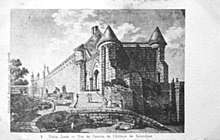Sadalberga
Saint Sadalberga (or Salaberga) (c. 605[1] – c. 670) was the daughter of Gundoin, Duke of Alsace and his wife Saretrude. Sadalberga founded the Abbey of St John at Laon. She is the subject of a short hagiography, the Vita Sadalbergae.
Saint Salaberga | |
|---|---|
 Abbaye Saint Jean,, Laon | |
| Abbess and foundress | |
| Born | c. 605 possibly Toul, France |
| Died | c. 670 Laon, France |
| Venerated in | Roman Catholic Church |
| Feast | September 22 |
Life
Gundoin of Alsace was on close terms with Waldebert, a Frankish nobleman who later became abbot of Luxeuil. Waldebert would come to guide Sadalberga in her monastic endeavors.[2] According to her anonymous vita, Gundoin had extended hospitality to Waldebert's predecessor, Saint Eustace of Luxeuil upon the Abbot's return from Bavaria, and Eustace had cured the child Sadalberga of blindness.[3]
Although she was drawn to religious life, her parents forced her to marry. Her first husband, Richramn, died after two months.[2] Then she was wed to a nobleman, Blandinus, a close counselor of King Dagobert. She had five children, Saretrude, Ebana, Anstrudis, Eustasius (died in infancy), and Baldwin (Baudoin). Her husband Blandinus and two of her children, Baldwin (feast day October 16) and Anstrudis, became saints. Sadalberga's brother was Saint Bodo (d. 670). After some years, she and Blandinus agreed mutually to separate and assume contemplative lives. He became a hermit and she went into a nunnery at Poulangey, accompanied by Anstrudis.
Encouraged by Waldebert, Salaberga founded the abbey of St. John the Baptist at Laon.[4] One of her kinsman had been bishop there, and his successor supported her efforts. She died there c. 670,[5]and was succeeded as abbess by her daughter, Anstrudis.[6]
Notes
- J. A. McNamara, J. E. Halborg, E. G. Whatley, eds. Sainted women of the Dark Ages (Duke University Press, 1992), p. 176.
- Fox, Yaniv. Power and Religion in Merovingian Gaul, Cambridge University Press, 2014 ISBN 9781107064591
- Alban Butler, Paul Burns, Butler's Lives of the Saints (Continuum International Publishing Group, 2000), 208.
- Laux, John Joseph. The Life and Witings of Saint Columban, Dolphin Press, 1914, p. 234

- Jamie Kreiner, The Social Life of Hagiography in the Merovingian Kingdom (Cambridge, 2014), p. 189.
- Le Jan, Regine. "Convents, Violence and Competition for Power on Francia", Topographies of Power in the Early Middle Ages, (Frans Theuws, Mayke B. de Jong, and Carine Van Rhijn eds.), p. 250, Brill, 2001 ISBN 9789004117341
![]()